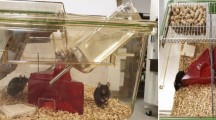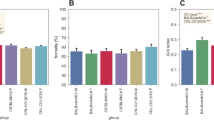Abstract
In order to improve the welfare of laboratory mice, a number of different environmental enrichment strategies have been developed to provide opportunities for mice to engage in naturalistic behaviors. Providing sufficient cage bedding for mice to use as a burrowing substrate could be considered an environmental enrichment strategy, but few studies have considered the welfare aspects of cage bedding amount. The authors compared the preferences of group-housed female BALB/c and C57BL/6 mice for three different volumes of cage bedding (0.5 l, 1.5 l and 6 l). Mice of both strains but especially C57BL/6 mice showed strong preferences for cages with more bedding. The results highlight the importance of providing a sufficient amount of cage bedding to laboratory mice.
This is a preview of subscription content, access via your institution
Access options
Subscribe to this journal
We are sorry, but there is no personal subscription option available for your country.
Buy this article
- Purchase on Springer Link
- Instant access to full article PDF
Prices may be subject to local taxes which are calculated during checkout




Similar content being viewed by others
References
De Boer, S.F. & Koolhaas, J.M. Defensive burying in rodents: ethology, neurobiology and psychopharmacology. Eur. J. Pharmacol. 463, 145–161 (2003).
Berry, R.J. The natural history of the house mouse. Field Stud. 3, 219–262 (1970).
Deacon, R.M. Burrowing: a sensitive behavioural assay, tested in five species of laboratory rodents. Behav. Brain Res. 200, 128–133 (2009).
Harper, S.J. & Batzli, G.O. Effects of predators on structure of the burrows of voles. J. Mamm. 77, 1114–1121 (1996).
Masuda, Y., Ishigooka, S. & Matsuda, Y. Digging behavior of ddY mouse. Exp. Anim. 49, 235–237 (2000).
Jirkof, P., Cesarovic, N., Rettich, A., Fleischmann, T. & Arras, M. Individual housing of female mice: influence on postsurgical behaviour and recovery. Lab. Anim. 46, 325–334 (2012).
Jirkof, P. et al. Burrowing behavior as an indicator of post-laparotomy pain in mice. Front. Behav. Neurosci. 4, 165 (2010).
Jirkof, P. et al. Burrowing is a sensitive behavioural assay for monitoring general wellbeing during dextran sulfate sodium colitis in laboratory mice. Lab. Anim. 47, 274–283 (2013).
Deacon, R.M. et al. Age-dependent and -independent behavioral deficits in Tg2576 mice. Behav. Brain. Res. 189, 126–138 (2008).
Cunningham, C. et al. Synaptic changes characterize early behavioural signs in the ME7 model of murine prion disease. Eur. J. Neurosci. 17, 2147–2155 (2003).
Deacon, R.M., Raley, J.M., Perry, V.H. & Rawlins, J.N. Burrowing into prion disease. Neuroreport 12, 2053–2057 (2001).
Deacon, R.M., Croucher, A. & Rawlins, J.N. Hippocampal cytotoxic lesion effects on species-typical behaviours in mice. Behav. Brain. Res. 132, 203–213 (2002).
Deacon, R.M., Penny, C. & Rawlins, J.N. Effects of medial prefrontal cortex cytotoxic lesions in mice. Behav. Brain. Res. 139, 139–155 (2003).
Jennings, M. et al. Refining rodent husbandry: the mouse. Report of the Rodent Refinement Working Party. Lab. Anim. 32, 233–259 (1998).
Deacon, R.M. Digging and marble burying in mice: simple methods for in vivo identification of biological impacts. Nat. Prot. 1, 122–124 (2006).
Gordon, C.J. Effect of cage bedding on temperature regulation and metabolism of group-housed female mice. Comp. Med. 54, 63–68 (2004).
Rosenbaum, M.D., VandeWoude, S. & Johnson, T.E. Effects of cage-change frequency and bedding volume on mice and their microenvironment. J. Am. Assoc. Lab. Anim. Sci. 48, 763–773 (2009).
Sherwin, C.M., Haug, E., Terkelsen, N. & Vadgama, M. Studies on the motivation for burrowing by laboratory mice. Appl. Anim. Behav. Sci. 88, 343–358 (2004).
King, J.A. & Weisman, R.G. Sand digging contingent upon bar pressing in deermice. Anim. Behav. 12, 446–450 (1964).
Adams, N. & Boice, R. Mouse (Mus) burrows: effects of age, strain, and domestication. Anim. Learn. Behav. 9, 140–144 (1981).
Van Rooijen, J. Preference tests, motivations, models and welfare. Appl. Anim. Ethol. 11, 1–6 (1983).
Van de Weerd, H.A., Van Loo, P.L., Van Zutphen, L.F., Koolhaas, J.M. & Baumans, V. Preferences for nesting material as environmental enrichment for laboratory mice. Lab. Anim. 31, 133–143 (1997).
Van de Weerd, H.A., Van Loo, P.L., Van Zutphen, L.F.M., Koolhaas, J.M. & Baumans, V. Strength of preference for nesting material as environmental enrichment for laboratory mice. Appl. Anim. Behav. Sci. 55, 369–382 (1998).
Kirchner, J., Hackbarth, H., Stelzer, H.D. & Tsai, P.P. Preferences of group-housed female mice regarding structure of softwood bedding. Lab. Anim. 46, 95–100 (2012).
Gaskill, B.N., Rohr, S.A., Pajor, E.A., Lucas, J.R. & Garner, J.P. Some like it hot: mouse temperature preferences in laboratory housing. Appl. Anim. Behav. Sci. 116, 279–285 (2009).
Nicklas, W. et al. Recommendations for the health monitoring of rodent and rabbit colonies in breeding and experimental units. Lab. Anim. 36, 20–42 (2002).
Blom, H.J. et al. Description and validation of a preference test system to evaluate housing conditions for laboratory mice. Appl. Anim. Behav. Sci. 35, 67–82 (1992).
Sherwin, C.M. Social context affects the motivation of laboratory mice, Mus musculus, to gain access to resources. Anim. Behav. 66, 649–655 (2003).
Sherwin, C.M. The motivation of group-housed laboratory mice, Mus musculus, for additional space. Anim. Behav. 67, 711–717 (2004).
Hauzenberger, A.R., Gebhardt-Henrich, S.G. & Steiger, A. The influence of bedding depth on behaviour in golden hamsters (Mesocricetus auratus). Appl. Anim. Behav. Sci. 100, 280–294 (2006).
Sluyter, F. & Van Oortmerssen, G.A. A mouse is not just a mouse. Anim. Welfare 9, 193–205 (2000).
Van Oortmerssen, G.A. Biological significance, genetics and evolutionary origin of variability in behaviour within and between inbred strains of mice (Mus musculus). A behaviour genetic study. Behaviour 23, 1–92 (1971).
Arnold, C.E. & Estep, D.Q. Laboratory caging preferences in golden hamsters (Mesocricetus auratus). Lab. Anim. 28, 232–238 (1994).
Sherwin, C.M. & Nicol, C.J. Reorganization of behaviour in laboratory mice, Mus musculus, with varying cost of access to resources. Anim. Behav. 51, 1087–1093 (1996).
Lightfoot, J.T., Turner, M.J., Daves, M., Vordermark, A. & Kleeberger, S.R. Genetic influence on daily wheel running activity level. Physiol. Genomics 19, 270–276 (2004).
Messeri, P., Oliverio, A. & Bovet, D. Relations between avoidance and activity: a diallele study in mice. Behav. Biol. 7, 733–742 (1972).
Blom, H.J., Van Tintelen, G., Van Vorstenbosch, C.J., Baumans, V. & Beynen, A.C. Preferences of mice and rats for types of bedding material. Lab. Anim. 30, 234–244 (1996).
Dawkins, M. Do hens suffer in battery cages? Environmental preferences and welfare. Anim. Behav. 25, 1034–1046 (1977).
Eskola, S., Lauhikari, M., Voipio, H.-M., Laitinen, M. & Nevalainen, T. Environmental enrichment may alter the number of rats needed to achieve statistical significance. Scand. J. Lab. Anim. Sci. 26, 134–144 (1999).
Tsai, P.P., Pachowsky, U., Stelzer, H.D. & Hackbarth, H. Impact of environmental enrichment in mice. 1: effect of housing conditions on body weight, organ weights and haematology in different strains. Lab. Anim. 36, 411–419 (2002).
Tsai, P.P., Stelzer, H.D., Hedrich, H.J. & Hackbarth, H. Are the effects of different enrichment designs on the physiology and behaviour of DBA/2 mice consistent? Lab. Anim. 37, 314–327 (2003).
Acknowledgements
Parts of the results were presented as a poster at the 12th FELASA/SECAL Congress held 10–13 June 2013 in Barcelona, Spain.
Author information
Authors and Affiliations
Corresponding author
Ethics declarations
Competing interests
The authors declare no competing financial interests.
Rights and permissions
About this article
Cite this article
Freymann, J., Tsai, PP., Stelzer, H. et al. The amount of cage bedding preferred by female BALB/c and C57BL/6 mice. Lab Anim 44, 17–22 (2015). https://doi.org/10.1038/laban.659
Received:
Accepted:
Published:
Issue Date:
DOI: https://doi.org/10.1038/laban.659
This article is cited by
-
What’s wrong with my experiment?: The impact of hidden variables on neuropsychopharmacology research
Neuropsychopharmacology (2022)



